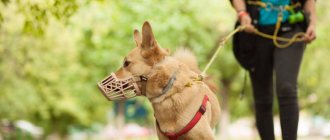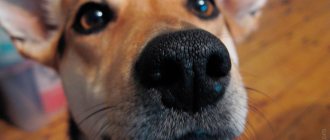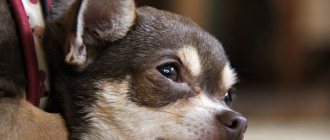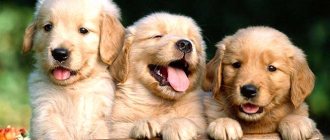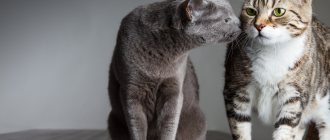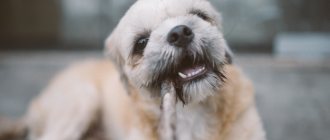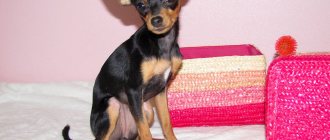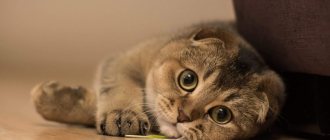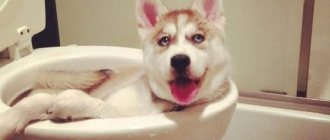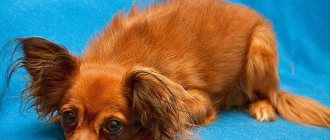Litter
The puppy needs to be provided with a comfortable, warm place to sleep and rest. This is best done with a bedding that is easy to clean and wash. To help your pet get used to the bed as quickly as possible, it is recommended to initially place a familiar toy or a piece of cloth with the mother’s scent next to it.
A good option is to place the puppy in a basket or a special house. But the owner should not let the puppy into his own bed, no matter how much he asks. This can be regarded as an element of training - the animal must feel the will of the owner and understand that it cannot achieve anything if it whines.
Preparing for the arrival of a puppy in the house
It is better to make all purchases of necessary accessories in advance, in consultation with the breeder. The puppy needs bedding or a house, as well as bowls, preferably on a stand. Toys are also absolutely necessary, especially those that can be chewed, and of course, a leash, collar or harness.
At first, until the puppy starts walking outside, you will need absorbent diapers, and when the puppy starts walking outside, you will need hygiene products - shampoo, conditioner and a comb. Don’t forget about the first aid kit - the veterinary department of the pet store will advise you on what products you need to purchase.
In addition, the set of “dowry” also depends on what time of year you get a puppy - it is better if it is the end of summer or beginning of autumn, then the baby will be able to grow up and get a little stronger before the winter frosts.
In winter and chilly autumn, you may need a blanket if we are talking about dogs of decorative breeds. Well, in May-June, you cannot do without special anti-tick remedies, which pose a huge danger to dogs, especially small and weakened ones. For reliability, it is better to use such a remedy, like anti-flea drugs, throughout the warm season.
At first, when we get a puppy, everything in the apartment will be foreign to him. To make the new home more familiar to your baby, you can use the following technique. When going to pick up a puppy, take a blanket, plush toy or any textile item with you. At the breeder's home, rub them on the fur of the puppy's mother and his brothers and sisters, so that the smell of his native den will help the pet calm down and fall asleep in its new home.
Collar and leash
The dog should be introduced to the collar as early as possible. One of the key factors here is size: two fingers should fit comfortably under the collar. As the puppy grows, this accessory will have to be changed periodically.
The defining qualities of a leash are strength and ease of control of the dog. The best option is a product made of genuine leather with welded metal fittings (by the way, this is also true for a collar). The recommended leash length is 1.8 meters. It allows you to control your pet without restricting its freedom of movement.
Toys
Toys serve the purpose of development and entertainment for the puppy. They should not only be interesting to the pet, but also safe. When choosing them, you need to pay attention to the material - it should be strong, durable, and not too hard. Size is important - a puppy cannot cope with a toy that is too large, and he will soon get bored with it. Here are some examples of toys that puppies will like: balls, rings, ducks and bones made of leather, soft plastic, rubber, jute sticks.
Toys and development
You can prepare a large selection of toys for your puppy, but what will he like? Most likely a tennis ball! Dogs just love them. But you need to choose not an ordinary one, but a special one
, specifically for dogs; as usual, they gnaw the skin and can swallow pieces, and the skin acts as an abrasive. Dog balls have a slightly different coating that is safe for your pet's teeth.
With toys, as it turned out, everything is not so simple: dogs don’t like everything, see the article TOP 20 most interesting toys for dogs.
So, our toys:
YG Sport Flying Disc. About 60 rub. At first it didn’t attract much interest, but playing with it while walking the dog turned out to be very fun! This is the most common model, but there are more durable Frisbees, especially for dogs.
Animal toy Cascade “Drum with a bell”, 4 x 4 x 4 cm. About 50 rub. This is probably only for small dogs... A 4-month-old medium-breed puppy found the toy for about 5 minutes, then a piece of plastic broke off and was taken away so that the dog would not get scratched.
Doglike “Tug & Twist DL”, for training. About 200 rub. Excellent thing! At first the puppy was not very interested in it, but once he got used to the new house and on walks, he became one of his favorite toys.
Zoonik dog toy “Rope. Eight". About 130 rub. The plastic rope, surprisingly, is still alive a couple of months later, although the dog has free access to the toy (which means he chews it mercilessly). The ropes are already partially chewed, but the toy is still intact.
Dog toy Doglike “Rope grab”, 2 knots, small 33 cm. About 70 rub. He didn’t live very long, but at first he was the most favorite toy of the puppy, who was just getting used to his new home.
Training toy for dogs GoSi “Hard Dog. Pipe", with two handles, length 30 cm. About 110 rub. The thing is just great, but it became interesting to us after five or six months. You didn’t have to buy it right away, but when it’s closer to six months, you’ll definitely need it for an adult dog! The strongest
toy.
Air Dog Toy "Tennis Ball", medium (3 pieces included), 6 cm. The KONG Air toy combines 2 traditional dog toys - a tennis ball and a squeaker, making it an ideal choice for playing fetch. This durable, high-quality ball will not damage your dog's teeth. Unlike traditional tennis balls, it is made of a special non-abrasive felt
. Floats on the water. The set contains 3 balls with a diameter of 6 cm. This set will last a long time.
Doglike dog toy “Ball with Ribbon” (orange), 6.5 cm. An excellent ball for training and playing with your dog. Lightweight and durable, retains elasticity in hot and cold weather, does not sink in water, and is safe for the dog’s teeth.
A funny fluffy ball with a squeaker from GiGwi - it’s so good that it’s even a little pity to give it to the dog to be torn to pieces, but it knows its stuff
, turned out to be surprisingly durable:
And our favorite toy: an elephant with a squeak and a rope, made of natural latex and cotton. The toy was quite thin, the tusks “ran out” immediately, and then it lived for some more time, after which it had to be picked up and thrown away. It was a rescue toy; it’s better to have several of these in reserve.
Transport accessories
Often there is a need to transport a puppy in your own car or on public transport, including to a veterinary clinic. For such moments, it is necessary to purchase specialized tools. These include, in particular, the container - it must match the size of the puppy and not be too tight. For large animals, a harness or seat belt is useful, reliably securing the animal in its place in the car.
Subscribe to our newsletter and get a free veterinary consultation
Thanks for subscribing!
RULES FOR RAISING A HEALTHY PUPPYPart 1. The basics of parenting Part 2. What you need to buy before the arrival of a puppy in your family Part 3. Vaccinations Part 4. How to toilet train Part 5. How to walk Part 6. Teeth growth Part 7. If the dog chews in the house Part 8. How feed Part 9. How to punish
Part 1. THE BASICS OF EDUCATION
You brought a little puppy home:
-remember that while the puppy is small, he is poorly protected from infections, so you must keep the house as clean as possible. For example, do not leave dirty shoes in the hallway, do not leave vegetables and fruits brought from the market available (since rodents are carriers of leptospirosis, and no one is safe from them in vegetable storage areas).
-You cannot lift the puppy up while holding it by its front paws.
-cannot be lifted with your palms covering your chest under your elbows (this can lead to “twisted elbows”).
-You should not allow a small puppy to jump from a chair, sofa, or generally jump from any high surfaces. Also, you don’t need to jump over benches with holes - you can break your paws.
- do not place a puppy, or even an adult dog, under the radiator - from too warm air the dog will simply begin to lose hair, and in general will become pampered.
-don’t be afraid to spoil the puppy with your love. This does not mean that you should give him food from the table and encourage all puppy nonsense (it will be difficult for you to live with such a dog later), but do not be afraid to overdo it in affection, games and expressing your love - then this will return to you with the love of your dog.
-remember the following rule: what is not allowed for an adult dog is also not allowed for a small puppy. For example, if you do not plan for your dog to lie on the sofa or sleep in your bed in the future, then do not let a small puppy there - do not encourage your dog to bark at the sounds of footsteps in the entrance, or at the barking of street dogs.
- it is very important to hide all electrical wires, and everything that the puppy can chew and eat, and thereby harm itself. It is recommended to initially put away your shoes and valuables. In this aspect of rearing, the basic rule should be: do not provoke the puppy, i.e. When leaving, leave only those items that the puppy can play with, and there should be more toys.
- before taking a puppy from a breeder, understand which actions of an adult dog will be encouraged by you, and which, on the contrary, will be strictly condemned. And subsequently always strictly follow these rules. Always scold your dog for some actions, and always praise for others. And never confuse the concepts of “good and bad.” And then the dog will quickly and clearly learn the behavior model that suits you.
If you have difficulties raising a dog, and it is difficult for you to cope with some element of behavior, then do not torture the dog and yourself, seek advice from a breeder or an experienced instructor whom you trust.
Part 2. WHAT YOU NEED TO BUY BEFORE A PUPPY ARRIVES IN YOUR FAMILY
- 2 bowls - for food and for water, it is very good if you immediately buy bowls on an iron lift, just buy large ones at once - for growth.
- toys (balls, rope braids, a ball on a rope, latex toys, just make sure your puppy chews rubber toys - in this case, he may eat rubber. You need to buy more toys so that the puppy does not switch his attention to useful objects And change them periodically - hide some and take out others.
- vein bones, ears (special ones in pet stores), just don’t give too much - it should be a delicacy.
- a place to sleep in, for starters, it’s made of foam, and of medium size (he will grow in it), and then when he grows in size, buy a permanent one. At first, a thick wool blanket folded in several layers can serve as a place for the puppy.
- brush for combing
- a leash and a collar, but only buy it at the age when you start taking it outside, because the puppy grows quickly. Do not buy collars that go over your head without unfastening.
- be sure to buy a tag for the collar and have it engraved on it, in a regular engraving workshop, with the dog’s name and your phone numbers, it is advisable to write as many phone numbers as possible. You can buy a special cylinder at the pet store in which paper with the same data is placed, but these cylinders often unwind, so you can try to coat the thread with nail polish when closing it.
- before taking your puppy outside, buy a special dog shampoo, since many puppies like to roll around in various carrions (perhaps, most likely, this will subside with age - do not beat the dog for this, but, of course, you can scold), and you may need an emergency need this shampoo.
Part 3. VACCINATIONS When you pick up a puppy, you should definitely ask whether the puppy was given anthelmintic drugs (and which ones) and whether they were vaccinated (with what vaccine). Puppies at the age of 1–2.5 months should receive their first vaccination. Vaccinate your dog only at state veterinary stations; only there will a vaccination stamp be placed in the dog’s veterinary passport, which is valid when traveling in transport, when visiting exhibitions, etc.
The first vaccination is carried out as follows: an anthelmetic is given 10–14 days in advance (Drontal + Junior is best), then a vaccination is given and quarantine follows for 14 days, after quarantine a second vaccination is given and another quarantine is 14–20 days. Only after the vaccination has been completed and the quarantine has been completed, you can go for a walk outside with the puppy.
The second vaccination is given to the puppy after changing teeth, at the age of 5.5–6 months. Before vaccination, an antihelmetic (Drontal + Junior) is given 5-7 days before vaccination, and after vaccination, a quarantine period of 14 days is maintained. During quarantine, it is better not to walk with your puppy.
The third vaccination is given to the dog at the age of 1 year. Before vaccination, an antihelmetic (Drontal + for adult dogs) is given 5–7 days before vaccination; after vaccination, you can go for a walk.
Further vaccinations are done once a year. Before vaccination, an anthelmintic is given 5–7 days before vaccination; in addition, it is recommended to give adult dogs an anthelmintic drug twice a year with an interval of 6 months. After any vaccination, hypothermia, getting wet and overexerting the dog are not allowed for 7-10 days.
Part 4. HOW TO TOILET TRAINING It is clear that the baby will pee at home for some time, wherever he wants. For some, this stops at 3 months, and the puppy begins to tolerate it and asks to go outside. For some it can last up to 5-7 months. A lot will depend on you here. It depends on how often you take him outside, how closely you watch the baby and feel when “it’s time.” But in any case, until you have completed all the vaccinations, you will not be able to walk outside, and the puppy will pee at home.
To prevent the puppy from getting dirty in the house, he must be taught to do things in a certain place. This can be done in several ways.
First way. The puppy is “allocated” to a room in the apartment, which is covered entirely with polyethylene, and newspapers are laid out on top. The puppy spends almost all his time in this room; he is not allowed to walk around the apartment freely. The puppy gets used to doing his business only on the newspaper. Gradually, the newspapers begin to be removed, leaving separately lying newspapers - the puppy should do things only on the newspapers; if he “misses,” the number of newspapers is increased. As a result, there should be one newspaper left in a certain place where it is convenient for the owners. You can, of course, cover the entire apartment with newspapers, but this is difficult and impractical.
Second way. A tray covered with newspapers is placed in a certain place in the apartment. The litter box should be 2-3 times larger than a standard cat litter box. After each sleep and feeding, the puppy is placed in the tray with the words “Do business”, his stomach is gently massaged and not released until the puppy poops and pees. It is very important every time the puppy wants to go to the toilet during play, have time to take him to the tray. In this way, you teach the puppy not only not to get dirty in the house, but also to go to the toilet on command. Toilet training this method is a little more difficult than the first, but it will greatly help you train your puppy to go to the toilet outside.
After vaccinations have been completed and quarantine has been completed, the puppy must be taught to go to the toilet outside. The sooner this happens, the easier it is for the puppy to adjust. After every sleep and meal, the puppy must be taken outside, the tummy must be massaged and the puppy must pee and poop. If the puppy in the apartment was trained to keep clean in the second way, then learning to do things outside will be easier. Going to the toilet on the street should not be considered a walk. That is, after the puppy has done her business, you can go for a walk, play or exercise with him, but under no circumstances before that!
The number of walks for a puppy should be 2-3 walks more than the number of feedings, after each feeding and immediately after a night's sleep and as late as possible in the evening before bedtime.
Part 5. HOW TO WALK
Before walking, the puppy must be accustomed to wearing a collar and leash. As a rule, a few wearings of a collar that is suitable in size and weight for the puppy are enough to get him used to it. The main thing is, after putting on the collar, do not let the puppy scratch it or pull it off; you need to distract the puppy with games and treats or affection. With a leash they work in the same way, only it takes a little more time to get used to a leash.
You can start walking your puppy only after the first course of vaccination and the required quarantine. As a rule, this occurs at 2.5–3 months. Puppies at this age are very brave in the apartment, but are often frightened by the noise and abundance of street smells, so it is worth taking some precautions.
The first walk is best done in not too cold weather (not lower than 10–15 degrees), in daylight, in a quiet corner of the yard, park or forest, away from roads and other dogs. The puppy must be kept on a leash.
After watching the puppy, you will notice that after sleep the puppy immediately goes to pour a puddle. Use this to start teaching your puppy to pee outside. As soon as the puppy wakes up, do not let him walk - with the puppy in your arms (or giving him to your household to hold), quickly get dressed and run outside. While the puppy is small and the weather is cold, walks will be short, so let's make them as intense as possible. Don’t let the walk take its course - play with the puppy, run, find sticks, play catch, walk around the yard (walk) not in a straight line, but in complex trajectories - let the puppy explore every piece. And at every opportunity, practice the command “Come to me!”: when the puppy is already running towards you, when he is confused and doesn’t know where to go, when he is scared - these are the ideal moments. Call in a joyful voice, as if you have been waiting for this moment all your life, and when the puppy runs up, rejoice even more! “Ay, well done! Good!”, pat lightly on the shoulder. Let your puppy understand how easy it is to bring you joy.
Never give a command if you know for sure that the puppy will not carry it out: for example, if he is playing with another dog, or is simply very passionate about something. The puppy should not have experience of not following a command. If you want to take the dog away, come and take it. And of course, never punish a dog when it comes by following a command (if, for example, the puppy found an unusually tasty, disgustingly stinking bone, or something like that). Otherwise, you can immediately come up with another command for calling and start practicing it. Talk to the puppy, discuss all aspects of the walk: the search for sticks, the appearance of dogs, the direction of movement, etc., tell where you will go and who you can meet there, as if you were talking to a child. Of course, the dog will never talk to you, but over time it will understand everything, believe me. This makes life a lot easier and increases the level of confidence incredibly. And this is exactly what we need to achieve, so that the puppy trusts you completely, so that you are more valuable to him than any bone, any dog.
After several walks, when the puppy is no longer afraid of the noise and smells of the street, you can carefully begin to let him off the leash. But this can only be done if the puppy firmly knows his name, his owner and follows the “Come to me” command well and there is no potential danger in the form of cars, dogs or people around. It is best to initially release the puppy in a well-fenced area, in a special dog area or in the country.
Once you are sure that the puppy is able to walk without a leash, does not run away, and comes on command, you can start letting him off the leash to play with other dogs. It is best to choose a clearing in a park or a well-protected yard from roads as a playground. For games, you need to choose a company of non-aggressive dogs; these can be adult, active, but not angry dogs, or puppies of about the same age and height as your puppy.
One of the most common misconceptions is that an adult dog will never hurt a puppy. How many dogs there are, so many options for the development of events. Therefore, when a dog appears on your way, ask its owner how his dog treats small children. If the answer is strictly negative, or you, without asking yet, see that the owner is frantically catching his dog, take the puppy away if the distance allows. You can carry it away in your arms, just don’t grab it sharply, and even in front of this ill-tempered dog - in this way you yourself open the hunt for puppies, and this, you know, is an extremely exciting activity. In addition, by sharply grabbing the puppy, you will show him your excitement, or even fear. And if a big man, support and defense is afraid, then something out of the ordinary has happened, which means you really should be afraid! But there is no point in scaring the puppy in vain. Just remember the dog's face and next time avoid it in advance.
Never allow your puppy to approach a dog on a leash. The calmest dog will probably begin to fiercely defend itself, bite and yell. This is a normal reaction. A dog on a leash, from the point of view of animal psychology, is in the so-called “safety zone”, beyond which it is no longer possible to retreat, so if you invade this zone, you can only fight tooth and nail. Why does a puppy need extra stress?
Remember that dogs learn from each other very quickly. Therefore, if you walk with another dog that has some specific habits that you would not want to see in your dog, it is better not to walk with this dog, because your dog can adopt these habits, and very quickly (this is, for example, there may be a habit of digging with his hind legs after using the toilet, running after cats, barking at other dogs). Moreover, what may be characteristic of other dogs due to innate character traits, such as dominance, aggression, imbalance, etc. - may simply become a bad habit in your dog who does not have these character traits.
Playing with dogs is wonderful, but as soon as you see that the puppy is tired, that he is tired of playing, that he is bored, that his gait has changed a little (you will notice this), that the puppy is simply cold - it’s time to go home. A walk should bring only positive emotions. A puppy who has been too tired at home cannot sleep, this makes him even more tired, not far from a nervous breakdown. There should be only one or two long walks per day (for a two-month-old puppy such a walk will be about 15 minutes, for a one-year-old puppy - an hour), the rest - just pee. Better not to go out!
Come home, you need to wash the puppy's paws. Place him in the bath, wash off the dirt from each leg, from the belly and chest, if necessary, with warm water. If the puppy is struggling, perhaps you need to make the water a little cooler (dogs don’t like very warm water), or maybe he is just scared of the unknown situation - calmly pet the puppy, in a very calm voice say that everything is fine, explain what you will do now and what later . And when it's over, cheerfully say something like: “See? Everything is fine! It's OK! Well done!". Be sure to tell your puppy when he does something right. It’s easy to say that you are unhappy with a puppy - it just rolls off the tongue, but don’t forget words like “You sit well!” when the puppy sits calmly in the car, “You behave well!” when he calmly tolerates washing his paws. Say these words in a very calm, almost confidential voice every time you like something in the puppy’s behavior - he should know it.
Once you've washed your paws, it's time to eat (of course, if the number of walks does not exceed the number of feedings). Never feed your puppy before a walk - the risk of intestinal volvulus is too high. After playing a little, the puppy will fall asleep. If he doesn’t succeed, you’ve been walking too long! Try to hold him on your knees, don’t let him rage, calmly, evenly stroke his neck (don’t scratch!), say something like: “Calm...Calm...” until he falls asleep. Then put it in its place. The puppy must sleep a lot - this is the key to a future good nervous system.
Part 6. GROWTH OF TEETH At 3.5–4 months, puppies begin to replace their milk teeth with molars. The teeth finally change by 6–7 months, depending on the breed.
At this time, the puppy needs to increase the amount of microelements supplied with food. Under no circumstances should you steal toys from your puppy. Don't let him chew the sticks, it's better to buy more bones from the veins.
Some puppies have baby teeth that are very tight and the molars cannot push them out. If you notice that your puppy has already lost a molar, but the baby tooth is not even loose, try loosening it yourself. If this does not work, then it is better to contact a veterinarian.
Part 7. IF A DOG IS GNIPPING IN THE HOUSE
It happens that the puppy begins to chew objects, furniture, wall corners, etc. Most often this happens when no one is home, the puppy is bored, scared, and in this simple way he tries to distract himself. In this case, first of all, you should remove all objects accessible to the teeth and leave the puppy plenty of toys, including a variety of edible sticks and bones from the veins. And, of course, do not leave the puppy alone for a long time until he gets used to his new home.
If the puppy deliberately tries to chew the same object (for example, the corner of the sofa), then you need to catch the moment of “gnawing” and scare the puppy by shouting loudly and throwing a bunch of keys at him. This procedure often needs to be done several times until the puppy understands the inevitability of punishment.
Sometimes it is advisable to lubricate the surface that is attractive to puppy teeth with a caustic or unpleasant-tasting substance. A good remedy is a mixture of pepper: water, caustic red and ground black pepper are mixed in a 1:1:1 ratio, and the surface is spread with this mixture. This mixture does not spoil the surface - the water evaporates quickly, and the pepper sticks, but is easily removed with a vacuum cleaner.
Do not lift the puppy by the scruff of the neck - this is a gesture of submission, and you risk raising the puppy to be a cowardly sycophant instead of a brave, independent dog.
If a growing puppy decides to assert itself and bites you, then under no circumstances hit him. Take the insolent one by the scruff of the neck (it’s good if you do it with your teeth) and shake it. It’s very good if you don’t scream and scold the puppy, but simply growl menacingly. And after shaking, lower the puppy to the ground and press him so that he cannot rise to his paws, and hold it until he whines. There is no need to hurt the puppy, the main thing is to put him in his place - the owner is always right.
Part 8. HOW TO FEED
Your very first command, and I must say the easiest and most useful, is the “wait” command. It is practiced very simply during the feeding process. Moreover, this is done immediately as soon as you brought the puppy home, there is no need to postpone it until later. So, you are going to feed the puppy. You call the puppy, place the bowl on a stand (or on the floor if there is no stand yet), but you do not let the puppy near the bowl, holding it with your hand. Then you sit him in front of the bowl (by lightly pressing on the croup and holding his chest in front), tell him the command to wait (wait), hold him for 1-2 seconds and then give him the command “eat” and only after that release him (rather than first releasing him and then giving him team). The first such lesson should be very short. Then gradually, by 1-2 seconds each time, or maybe 2-3 times, increase the interval between the commands “wait” and “eat”. Very soon you will see that you remove your hands, and the dog sits and waits for the command to “eat”. This is a very useful command for developing endurance. You can sometimes increase the exposure period to 2-3 minutes. But there is no need to abuse the long waiting period in this particular team. It won't do any good for your dog to drool for 10-20 minutes near his food bowl. And yet, the holding time should not always be the same, otherwise the dog, in the end, may start eating without your command, for example, after 10 seconds. That is, the holding time must be varied.
If after feeding the dog leaves food in the bowl, you can leave the bowl for 15 minutes, and then be sure to remove it until the next feeding. Under no circumstances leave the bowl out in the open all day. If the dog hasn’t finished eating or, perhaps, hasn’t touched the food at all (he just winced in disgust, looked at you reproachfully, walked away and looked at the refrigerator like an orphan), the bowl is removed! Under no circumstances should you persuade your dog to eat, never feed him by hand, never offer other food to replace the one he refused! One of the reasons for the refusal may be that dogs sometimes arrange fasting days for themselves when they do not eat at all. This is completely normal. Another reason for refusing to eat may be that the dog decided to check whether it is possible to train you? I’ll make an unhappy face, tighten my stomach, and after a couple of lessons the compassionate owner will offer me a varied menu: from fresh cottage cheese from the market to steamed beef, cut into pieces of the shape I like. And do you think they will stop there? No! It was only necessary to remove the bowl in time and not give in to persuasion. At the very beginning, show who is boss in the house and who is training whom. Please note that now that the puppies eat in a “group”, everyone eats quickly and without any questions asked. You do not have such an accelerating factor at home as a brother or another brother, you must replace them! We put the bowl, the dog eats (or doesn’t eat - that’s his problem!), remove the bowl. In 4 days of complete fasting, the dog’s intestines are only completely emptied - he still does not even think about dying from exhaustion. We are not trainable!
There is one case when you should feed your dog by hand. The dog must know that you are the head of the pack and have the right to get into the bowl while eating. Move the bowl, mix the food with your finger, feed it by hand. The dog should under no circumstances growl. If this happens, slap the dog in the face with a newspaper (not with your hand! People's hands bring only positive emotions!) or shake it by the scruff of the neck. Hover over the dachshund, menacingly, in a low voice, ask something like: “What is this?!” And again with your hand - into the bowl. Hand feed a little. Repeat next time. The dog should be absolutely calm about your manipulations with the bowl. Check from time to time to see if this is true.
From the very beginning, we teach everyone in the family not to feed the dog scraps from the table. A puppy that comes to your house does not know that it is possible to ask for, or even demand, part of your food. But it costs nothing for a dog to learn this! Step on your heart, trample pity in the bud, but don’t give anything to the unfortunate orphan sitting under the table and looking for your eyes. Dogs have well-developed facial expressions and they use them masterfully. Rest assured, if the puppy catches your doubtful glance, he will make his face even more unhappy! And now you already believe that this emaciated animal has not eaten for a week, and a small piece of bread will not do anything bad... Stop! The recipe is simple - do not look at the dog while eating. No dog at this time. Watch your family carefully - no secret pieces. It’s better if the puppy grows up without knowing what it means to ask at the table. Otherwise, very soon you will be eating in a drama theater, and even with musical accompaniment. You will eat quickly, sending half of your plate (already completely automatically) into the satisfied dog’s mouth. The dog will be able to be proud of the result of his training. Another argument against pieces: a mixed diet is the cause of gastritis, remember?
From the very first feeding, you can call puppies to the bowls by clapping your hands. This will be their first conditioned reflex: clapping will lead to pleasant things. Then, during a walk, you can call them with the same claps along with the command “Come to me!” The puppies will run towards you as fast as they can. There, instead of food, your wild joy will await them. For dogs, food and the joy of the owner are equal things. Use these well-learned skills: call for food with claps with the words “Eat!”, call the puppy with claps with the words “Come!”, don’t forget to show your joy!
Part 9. HOW TO PUNISH
The puppy will definitely do something wrong. If only to find out that this cannot be done. It is necessary to explain the rules of the house clearly, without rudeness. You need to explain in words, as if it were a child. But you can also enhance the effect of words. For example, if a puppy is chewing on the sofa, you take a newspaper and say: “You can’t!” and, if the puppy doesn’t stop, you immediately slap the newspaper in the face. The newspaper is not painful, it is rather offensive. The puppy, of course, will be very surprised (“Why did that boom like that?”) and try again. Maybe not right away, but in about five minutes, in an hour or tomorrow - definitely: “Okay, now it’s impossible, but at this minute?” Well, what if it’s possible? The puppy should check! Different children check different numbers of times. This is not out of harm, it is out of a healthy interest in life - after all, experiments are also done many times in order to understand that the result is natural and not a mere accident. As a child, a puppy must thoroughly learn not only where the bowl is in the apartment and where the bed is, but also all the rules of the house. Explain to him! On the street you can use not a newspaper, but a thin twig. If necessary.
There are times when newspapers are not enough. For example, if a puppy tries to download his license. You want to take his bone (and this should be done regularly), but he snaps and even tries to bite. Here it’s worth showing who’s boss. You take the puppy by the scruff of the neck, shake it until it squeaks, you can press the scruff of the neck to the floor, hang over it, make a menacing face and growl. Adult dogs also make faces when they want to show their displeasure - no one immediately starts fighting. You only let the bully go when he stops growling and accepts his fate. After this, you can try to take the bone again, hold it so that the puppy gnaws it from your hand. In the case considered, the one who tried to take the bone and received a rebuff should be punished. Complaining to someone is unacceptable - this will only confirm to the dog that your status in the pack is not that high, since you are asking for help. You can punish only immediately after, or better yet during, hooliganism. Otherwise, you might think that you were punished for something else.
You cannot hit dogs with your hand under any circumstances! People's hands bring only positive emotions! Otherwise, the dog will be afraid of you and expect the worst, and this is such a sad sight. Your task is to become one family, one organism, to understand each other perfectly.
